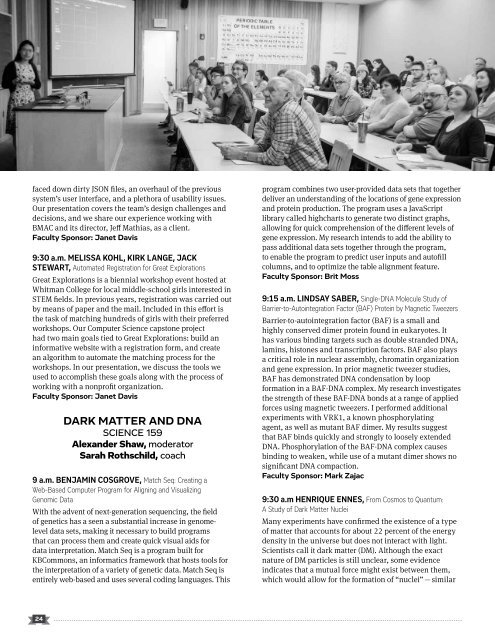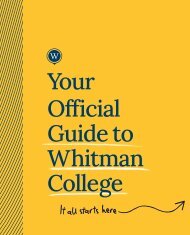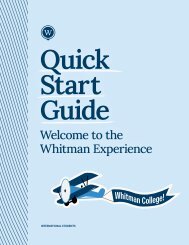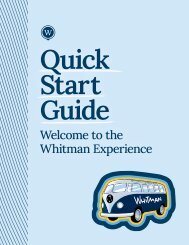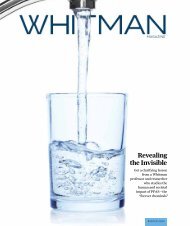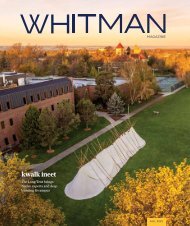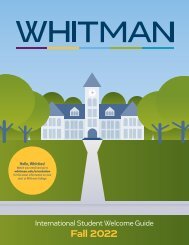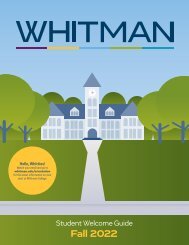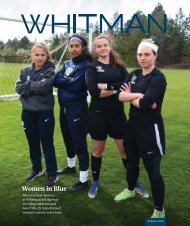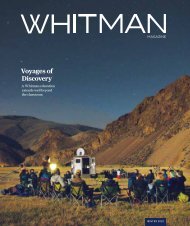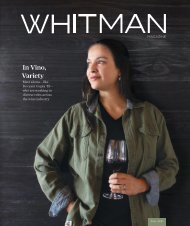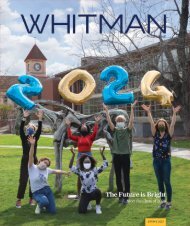You also want an ePaper? Increase the reach of your titles
YUMPU automatically turns print PDFs into web optimized ePapers that Google loves.
faced down dirty JSON files, an overhaul of the previous<br />
system’s user interface, and a plethora of usability issues.<br />
Our presentation covers the team’s design challenges and<br />
decisions, and we share our experience working with<br />
BMAC and its director, Jeff Mathias, as a client.<br />
Faculty Sponsor: Janet Davis<br />
9:30 a.m. MELISSA KOHL, KIRK LANGE, JACK<br />
STEWART, Automated Registration for Great Explorations<br />
Great Explorations is a biennial workshop event hosted at<br />
Whitman College for local middle-school girls interested in<br />
STEM fields. In previous years, registration was carried out<br />
by means of paper and the mail. Included in this effort is<br />
the task of matching hundreds of girls with their preferred<br />
workshops. Our Computer Science capstone project<br />
had two main goals tied to Great Explorations: build an<br />
informative website with a registration form, and create<br />
an algorithm to automate the matching process for the<br />
workshops. In our presentation, we discuss the tools we<br />
used to accomplish these goals along with the process of<br />
working with a nonprofit organization.<br />
Faculty Sponsor: Janet Davis<br />
DARK MATTER AND DNA<br />
SCIENCE 159<br />
Alexander Shaw, moderator<br />
Sarah Rothschild, coach<br />
9 a.m. BENJAMIN COSGROVE, Match Seq: Creating a<br />
Web-Based Computer Program for Aligning and Visualizing<br />
Genomic Data<br />
With the advent of next-generation sequencing, the field<br />
of genetics has a seen a substantial increase in genomelevel<br />
data sets, making it necessary to build <strong>program</strong>s<br />
that can process them and create quick visual aids for<br />
data interpretation. Match Seq is a <strong>program</strong> built for<br />
KBCommons, an informatics framework that hosts tools for<br />
the interpretation of a variety of genetic data. Match Seq is<br />
entirely web-based and uses several coding languages. This<br />
<strong>program</strong> combines two user-provided data sets that together<br />
deliver an understanding of the locations of gene expression<br />
and protein production. The <strong>program</strong> uses a JavaScript<br />
library called highcharts to generate two distinct graphs,<br />
allowing for quick comprehension of the different levels of<br />
gene expression. My research intends to add the ability to<br />
pass additional data sets together through the <strong>program</strong>,<br />
to enable the <strong>program</strong> to predict user inputs and autofill<br />
columns, and to optimize the table alignment feature.<br />
Faculty Sponsor: Brit Moss<br />
9:15 a.m. LINDSAY SABER, Single-DNA Molecule Study of<br />
Barrier-to-Autointegration Factor (BAF) Protein by Magnetic Tweezers<br />
Barrier-to-autointegration factor (BAF) is a small and<br />
highly conserved dimer protein found in eukaryotes. It<br />
has various binding targets such as double stranded DNA,<br />
lamins, histones and transcription factors. BAF also plays<br />
a critical role in nuclear assembly, chromatin organization<br />
and gene expression. In prior magnetic tweezer studies,<br />
BAF has demonstrated DNA condensation by loop<br />
formation in a BAF-DNA complex. My research investigates<br />
the strength of these BAF-DNA bonds at a range of applied<br />
forces using magnetic tweezers. I performed additional<br />
experiments with VRK1, a known phosphorylating<br />
agent, as well as mutant BAF dimer. My results suggest<br />
that BAF binds quickly and strongly to loosely extended<br />
DNA. Phosphorylation of the BAF-DNA complex causes<br />
binding to weaken, while use of a mutant dimer shows no<br />
significant DNA compaction.<br />
Faculty Sponsor: Mark Zajac<br />
9:30 a.m HENRIQUE ENNES, From Cosmos to Quantum:<br />
A Study of Dark Matter Nuclei<br />
Many experiments have confirmed the existence of a type<br />
of matter that accounts for about 22 percent of the energy<br />
density in the universe but does not interact with light.<br />
Scientists call it dark matter (DM). Although the exact<br />
nature of DM particles is still unclear, some evidence<br />
indicates that a mutual force might exist between them,<br />
which would allow for the formation of “nuclei” — similar<br />
24


